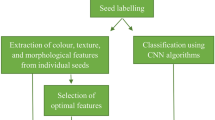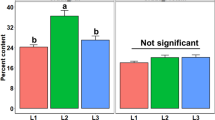Abstract
Cereal grains and oilseeds, fundamental components of global diets, face significant vulnerability to mechanical damage during various stages, including harvesting, transportation, and storage. Beyond immediate physical degradation, the repercussions of such damage extend to seed viability and consequent economic implications. Traditional assessment techniques, predominantly reliant on external visual inspections, face challenges of subjectivity and inefficiency, restricting evaluations to superficial seed alterations. To circumvent these shortcomings, this study presents a fusion of optical techniques, namely two-dimensional (2D) X-ray imaging and hyperspectral imaging (HSI) – all underpinned by machine learning and deep learning frameworks – targeting an automated, holistic assessment of flaxseed damages. Leveraging an expansive dataset of 3,600 flaxseed samples spanning varied moisture contents and impact energies, the findings underscore the amplified susceptibility of seeds to damage under heightened impact stress at minimal moisture levels. Remarkably, through the integrated approach, the study achieved classification accuracies surpassing 87% for all techniques. While X-ray imaging presented throughput limitations, Vis-NIR HSI can be considered an effective alternative. In summation, the study accentuates the profound potential harboured by optical techniques in seed damage assessments, advocating their capacity to replace conventional methods. By seamlessly integrating advanced imaging with computational intelligence, the study not only streamlines damage detection but also amplifies the possibility of curbing damage, promising heightened yields and minimized economic setbacks. Future endeavors should channel this foundational research towards broader crop varieties to ensure universal applicability and validation.
Access provided by Autonomous University of Puebla. Download conference paper PDF
Similar content being viewed by others
Keywords
1 Introduction
As a cornerstone of global nutrition, cereal grains and oilseeds play a pivotal role in dietary sustenance. However, the journey of these crops, from field to consumer, is fraught with mechanical challenges. In particular, operations like harvesting, transportation, and storage have been recognized as key stages where these grains face potential damage [1]. This damage not only reduces the aesthetic appeal of the grain but also impinges upon its nutritional quality, viability, and overall market value.
Conventional methods to assess these damages have traditionally centred on visual examinations. While seemingly straightforward, such methods are inherently flawed. They are subjective, labor-intensive, and perhaps most critically, restricted in scope – capturing only the external damages while turning a blind eye to the nuanced, internal damages that could have long-term implications on the grain's shelf life, susceptibility to pests, and nutritional quality.
In an age where technology and agriculture are becoming inextricably linked, clinging to outdated methods feels like a squandered opportunity. Consequently, many researchers are delving into innovative tools and mathematical models to forecast the susceptibility of seeds to mechanical damage under varying moisture contents and impact energies [2,3,4,5,6,7,8,9,10,11,12,13]. Among the emerging techniques, optical methodologies, especially imaging and spectroscopy, have garnered significant attention, marking a paradigm shift in the research landscape [14, 15]. Riding this wave of innovation, our research pivots its focus on the comparative strengths and nuances of 2D X-ray imaging and hyperspectral imaging (HSI) in gauging seed damage, spotlighting flaxseeds for their global economic and nutritional footprint. Through this endeavor, we envision a confluence of state-of-the-art technology and agronomic expertise to craft a comprehensive, efficient, and robust system, capable of mapping both the seen and unseen damages in seeds, ensuring no facet of damage goes undetected.
2 Methods
Flaxseed samples were sourced from Arborg, Manitoba, Canada, and conditioned to moisture contents (MCs) of 6, 8, and 11.5% on a wet basis as described in detail elsewhere [16]. The seeds were then subjected to varying mechanical forces, using a drop weight impactor, at three distinct energy levels of 2, 4, and 6 mJ [17, 18]. These energy intensities were selected from preliminary tests to induce low, medium, and high levels of kernel damage to the flaxseed. In addition to the impacted samples, a set of control samples for each moisture content was incorporated, which were unexposed to any mechanical impact. The comprehensive experiment encompassed a total of 3600 seeds, spanning over 100 seeds for each of the 4 impact energies, three moisture contents, and with each combination replicated three times.
To ascertain the internal damages incurred by the seeds, a 2D X-ray imaging system (Model: MX-20, Faxitron Bioptics, LLC, Tucson, AZ) was utilized to render an internal view of the seeds. Furthermore, to garner hyperspectral imaging (HSI) data ranging from 400–1000 nm, a visible-near-infrared (Vis-NIR) HSI system from SPECIM Spectral Imaging Ltd., Oulu, Finland, was employed.
The X-ray data procured underwent rigorous analysis using the Matlab software suite (Mathworks Inc., Waltham, MA). Gray-level percentile scores provided an initial assessment [17], which was supplemented by the efficientNet-B0 model, a variant of convolutional neural network (CNN) [18]. Lastly, to classify seeds as sound or damaged based on the HSI data, a partial least squares discriminant analysis (PLS-DA) was carried out.
3 Results and Discussions
Figure 1 shows the digital image of flaxseeds with 8% MC under different impact stresses. It is apparent that inducing impact stress increases mechanical damage to seeds. Similar patterns were observed for other combinations of moisture contents and impact stress, as detailed in our earlier publications [17, 18]. The 2D X-ray images (Fig. 2) offer a more nuanced perspective, particularly highlighting the internal seed damages that are not always externally visible. In our preceding studies, we delved into the analysis of these 2D X-ray images. Leveraging gray-level percentile scores and the Support vector machine (SVM) classifier, flaxseeds were categorized into two primary groups: nil/low and medium/high damage with a classification accuracy of 87% [17]. Amplifying this process with convolutional neural networks (CNN) and transfer learning methodologies, particularly the EfficientNet-B0 model, catapulted the classification accuracy to a commendable 95% [18]. The confusion matrix of a test set (30% of the entire data), delineating the classification of seeds using CNN into the aforementioned groups, is outlined in Table 1.
Despite the undeniable prowess of X-ray systems in revealing detailed internal damages, their practical application in large-scale seed assessments is not without challenges. The first major obstacle is their constrained throughput performance; the time and resources required to scan extensive seed batches can be substantial. Secondly, the use of X-ray systems invariably introduces concerns regarding safety, especially in settings where continuous or prolonged use is necessitated. These inherent limitations of X-ray technology prompted us to seek out alternatives that could maintain a high level of accuracy while addressing these challenges.
In our quest for a suitable substitute, we turned our attention to the Vis-NIR HSI technique. This technology, renowned for its non-destructive and rapid analytical capabilities, emerged as a promising candidate. Our initial forays into Vis-NIR HSI involved processing the gathered data through mean centering, which aims to eliminate systematic biases. To further refine our data interpretation, PLS-DA model was tailored for supervised classification. Encouragingly, this approach yielded a classification accuracy of 89% under 5-fold cross-validation, positioning it competitively with the results achieved through X-ray systems.
While these preliminary findings showcase the potential of Vis-NIR HSI as a robust alternative to traditional X-ray imaging, they represent just the tip of the iceberg. The vast and intricate realm of possibilities proffered by Vis-NIR HSI beckons for more rigorous and comprehensive explorations to genuinely leverage its expansive capabilities in seed damage evaluations.
One should note that a challenge in implementing both the 2D X-ray and HSI systems lies in the complexity of analyzing large HSI datasets and the need for automating X-ray analysis for diverse seeds. While HSI systems typically come with a higher price tag compared to traditional spectroscopy systems, identifying key wavelengths can significantly minimize computational demands. This paves the way for multi-spectral systems, which are more cost-effective than full-fledged hyperspectral setups, streamlining analysis and reducing costs. As for X-ray imaging, automation would not only expedite the evaluation but also enhance its accuracy by mitigating human error and subjectivity. Exploring these areas further can potentially redefine seed evaluation, making it both more precise and economically viable.
In forthcoming research, we intend to delve into a meticulous analysis, prioritize wavelength selection, and undertake principle component analysis to further refine our approach and insights.
4 Conclusion
Overall, this study highlights the untapped potential of optical techniques in evaluating mechanical damage to seeds. The results suggest that implementing machine learning tools with optical techniques such as 2D X-ray imaging and HSI can provide a rapid and reliable alternative to the subjective and time-consuming visual inspection method. The outcomes of this research can contribute to developing new technologies for detecting and/or preventing damage, resulting in increased crop yields and reduced economic losses for stakeholders. However, to validate these findings, further testing should be performed on a wider range of crops.
References
Nadimi M, Hawley E, Liu J, Hildebrand K, Sopiwnyk E, Paliwal J (2023) Enhancing traceability of wheat quality through the supply chain. Compr Rev Food Sci Food Saf. https://doi.org/10.1111/1541-4337.13150
Shahbazi R, Shahbazi F (2022) Effects of cushion box and closed let-down ladder usage on mechanical damage during corn kernel handling: cracking. J Stored Prod Res 99:102006. https://doi.org/10.1016/J.JSPR.2022.102006
Shahbazi R, Shahbazi F (2022) Effects of cushion box and closed let-down ladder usage on damage to corn during handling: physiological deterioration. Plant Methods 18(1):1–11. https://doi.org/10.1186/S13007-022-00975-Y/TABLES/4
Shahbazi R, Shahbazi F (2023) Effects of cushion box and closed let-down ladder usage on impact damage to corn kernel during handling. Food Sci Nutr 11(5):2243–2253. https://doi.org/10.1002/FSN3.3137
Shahbazi F (2011) Impact damage to chickpea seeds as affected by moisture content and impact velocity. Appl Eng Agric 27(5):771–775. https://doi.org/10.13031/2013.39557
Shahbazi R, Shahbazi F, Nadimi M, Paliwal J (2023) Assessing the effects of free fall conditions on damage to corn seeds: a comprehensive examination of contributing factors. AgriEngineering 5(2):1104–1117. https://doi.org/10.3390/AGRIENGINEERING5020070
Shahbazi F, Dolatshah A, Valizadeh S (2014) Evaluation and modelling the mechanical damage to cowpea seeds under impact loading. Qual Assur Saf Crops Foods 6(4):453–458. https://doi.org/10.3920/QAS2012.0120
Shahbazi F, Dowlatshah A, Valizadeh S (2012) Breakage susceptibility of wheat and triticale seeds related to moisture content and impact energy. Cercetari Agronomice Moldova 45(3):5–13. https://doi.org/10.2478/v10298-012-0051-4
Shahbazi F, Valizade S, Dowlatshah A (2017) Mechanical damage to green and red lentil seeds. Food Sci Nutr 5(4):943–947. https://doi.org/10.1002/fsn3.480
Delfan F, Shahbazi F, Esvand HR (2023) Impact damage to chickpea seeds during free fall. Int Agrophys 37(1):41–49. https://doi.org/10.31545/INTAGR/156049
Khazaei J, Shahbazi F, Massah J, Nikravesh M, Kianmehr MH (2008) Evaluation and modeling of physical and physiological damage to wheat seeds under successive impact loadings: mathematical and neural networks modeling. Crop Sci 48(4):1532–1544. https://doi.org/10.2135/cropsci2007.04.0187
Shahbazi F, Sharafi R, Moomevandi SJ, Daneshvar M (2015) Influence of foliar iron fertilization rate on the breakage susceptibility of wheat seeds. J Plant Nutr 38(14):2204–2216. https://doi.org/10.1080/01904167.2015.1043379
Chen Z, Wassgren C, Kingsly Ambrose RP (2020) A review of grain kernel damage: mechanisms, modeling, and testing procedures. Trans ASABE 63(2):455–475. https://doi.org/10.13031/trans.13643
Gomes-Junior FG, Cicero SM, Vaz CMP, Lasso PRO (2019) X-ray microtomography in comparison to radiographic analysis of mechanically damaged maize seeds and its effect on seed germination. Acta Sci Agron 41(1):e42608. https://doi.org/10.4025/ACTASCIAGRON.V41I1.42608
Wang L, Huang Z, Wang R (2021) Discrimination of cracked soybean seeds by near-infrared spectroscopy and random forest variable selection. Infrared Phys Technol 115:103731. https://doi.org/10.1016/J.INFRARED.2021.103731
Mundhada S, Chaudhry MMA, Erkinbaev C, Paliwal J (2022) Development of safe storage guidelines for prairie-grown flaxseed. J Stored Prod Res 97:101965. https://doi.org/10.1016/J.JSPR.2022.101965
Nadimi M, Loewen G, Paliwal J (2022) Assessment of mechanical damage to flaxseeds using radiographic imaging and tomography. Smart Agric Technol 2:100057. https://doi.org/10.1016/j.atech.2022.100057
Nadimi M, Divyanth LG, Paliwal J (2023) Automated detection of mechanical damage in flaxseeds using radiographic imaging and machine learning. Food Bioproc Tech 16(3):526–536. https://doi.org/10.1007/S11947-022-02939-5/METRICS
Author information
Authors and Affiliations
Corresponding author
Editor information
Editors and Affiliations
Rights and permissions
Copyright information
© 2024 The Author(s), under exclusive license to Springer Nature Switzerland AG
About this paper
Cite this paper
Nadimi, M., Paliwal, J. (2024). Optical Techniques for Automated Evaluation of Seed Damage. In: Cavallo, E., Auat Cheein, F., Marinello, F., Saçılık, K., Muthukumarappan, K., Abhilash, P.C. (eds) 15th International Congress on Agricultural Mechanization and Energy in Agriculture. ANKAgEng 2023. Lecture Notes in Civil Engineering, vol 458. Springer, Cham. https://doi.org/10.1007/978-3-031-51579-8_13
Download citation
DOI: https://doi.org/10.1007/978-3-031-51579-8_13
Published:
Publisher Name: Springer, Cham
Print ISBN: 978-3-031-51578-1
Online ISBN: 978-3-031-51579-8
eBook Packages: EngineeringEngineering (R0)







